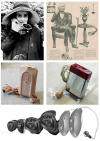Toward Alleviating the Stigma of Hearing Aids: A Review
- PMID: 39727610
- PMCID: PMC11673210
- DOI: 10.3390/audiolres14060087
Toward Alleviating the Stigma of Hearing Aids: A Review
Abstract
Despite the significant advancements in hearing aid technology, their adoption rates remain low, with stigma continuing to be a major barrier for many. This review aims to assess the origins and current state of hearing aid stigma, as well as explore potential strategies for alleviating it. This review examines the societal perceptions, psychological impacts, and recent technological advancements that can influence hearing aid adoption and reduce stigma. Methods: A narrative-focused review of the literature from peer-reviewed journals and reputable sources was conducted, analyzing papers on hearing aid stigma, adoption rates, and technological solutions. The research works were categorized based on their focus on the drivers and alleviation strategies for the stigma of hearing aids. Results: This review identifies stigma as a complex, multifaceted issue driven primarily by ageism, disability perception, and the association of hearing aids with aging and incapability. Despite technological improvements, the studies surveyed listed stigma as a major factor in non-adoption. Technological advancements such as artificial intelligence in sound processing, multifunctional features, and innovative design have shown potential in reducing stigma and improving user experience. Conclusions: Alleviating the stigma of hearing aids requires a multi-pronged approach, combining improvements in technology with changes in societal perceptions. Multifunctional devices including both health and communications functions, advanced signal processing, and esthetic improvements can drive their adoption, but broader public health awareness and education are also essential to changing societal attitudes and fostering greater acceptance of hearing aids.
Keywords: adoption rate; design; functionality; hearing aid; hearing loss; stigma.
Conflict of interest statement
Achintya K. Bhowmik is an employee of Starkey Hearing. The paper reflects the views of the scientists, and not the company.
Figures




References
-
- Schnupp J., Nelken I., King A. Auditory Neuroscience: Making Sense of Sound. MIT Press; Cambridge, MA, USA: 2011. - DOI
-
- World Health Organization World Report on Hearing. World Health Organization. 2021. [(accessed on 12 October 2024)]. Available online: https://iris.who.int/bitstream/handle/10665/339956/9789240021570-eng.pdf....
-
- Fabry D. America Must Confront Hearing Loss: Column. USA Today. Dec 14, 2015. [(accessed on 12 October 2024)]. Available online: https://www.usatoday.com/story/opinion/2015/12/14/hearing-loss-deaf-ment...
Publication types
LinkOut - more resources
Full Text Sources

